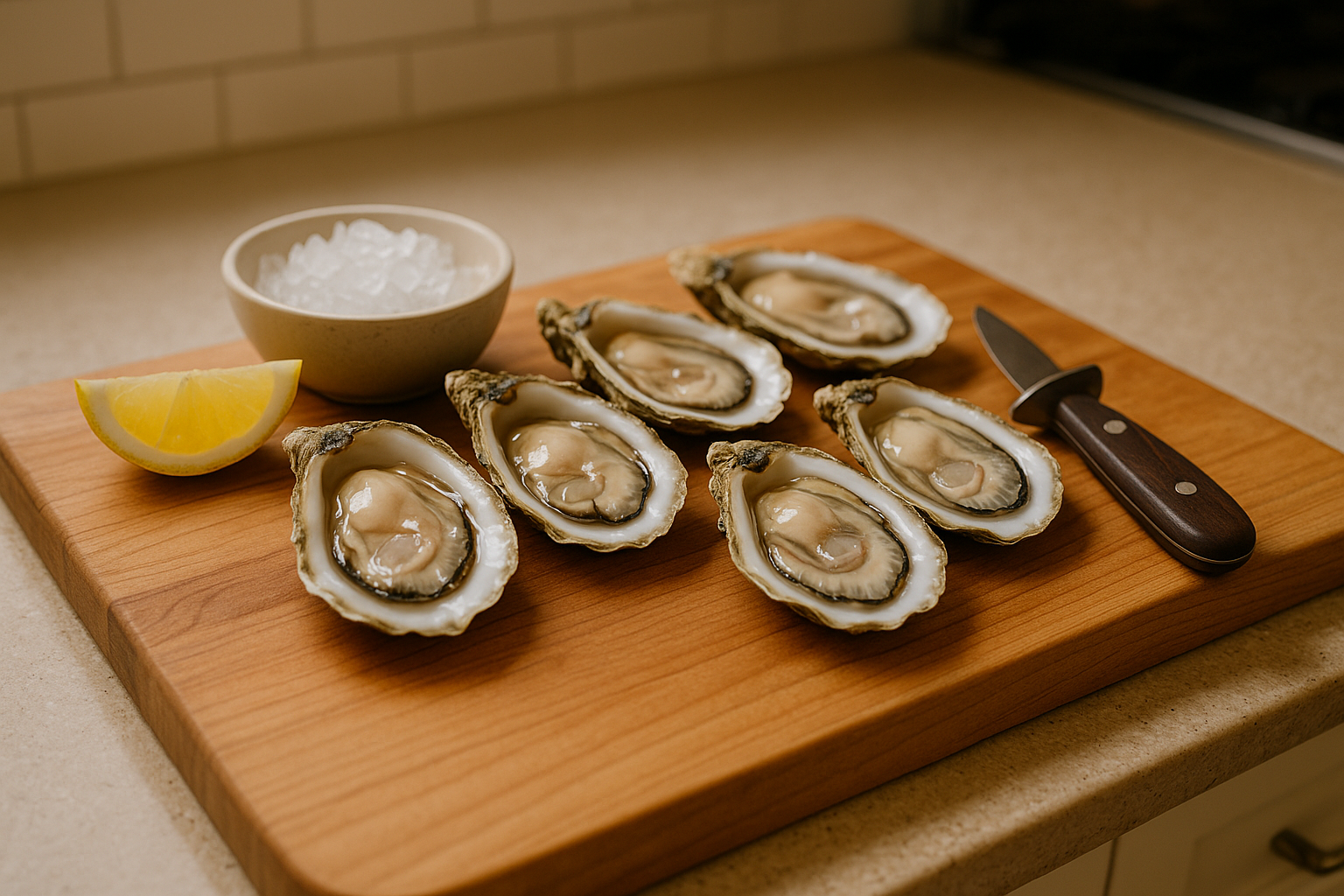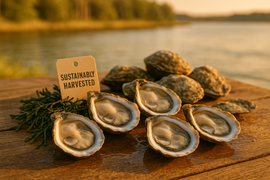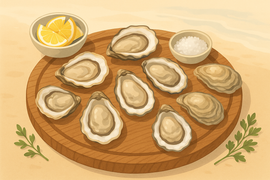-
Inspect the Shell
- Look for tightly closed, clean, and undamaged shells.
- Tap slightly open shells - if they don’t close, discard them.
-
Check the Liquid
- Fresh oysters have clear, salty liquid.
- Cloudy, murky, or no liquid? Toss it.
- Smell the liquid - it should remind you of the ocean, not ammonia or fish.
-
Examine the Meat
- Fresh meat is plump, shiny, and slightly translucent.
- Avoid oysters with dry, shriveled, or discolored meat.
-
Store Properly
- Keep oysters at 35–40°F.
- Consume live oysters within 7 days and shucked ones within 5 days.
Quick Reference Table
| Check | Fresh Oysters | Spoiled Oysters |
|---|---|---|
| Shell | Tightly closed or closes when tapped | Open, cracked, or unresponsive |
| Liquid | Clear, salty, ocean-like smell | Cloudy, murky, strong fishy/ammonia smell |
| Meat | Plump, shiny, moist | Dry, discolored, slimy, or shriveled |
What is a bad Oyster?
1. Check the Shell Condition
Inspecting the shell is the first step in making sure your oysters are fresh and safe to eat.
Examine the Shell
An oyster's shell can tell you a lot about its quality. Here's what to look for:
- Shell integrity: Cracks or chips could mean the oyster is compromised [4].
- Surface cleanliness: A clean shell without sediment or barnacles is a good sign [5].
- Shell closure: Fresh oysters have tightly closed shells [2].
Once you've checked the shell's appearance, it's time to see how it responds.
Test the Shell's Responsiveness
After ensuring the shell looks good, test whether the oyster is alive by checking its reaction.
If the shell is slightly open, give it a gentle tap. A live oyster will quickly close its shell. If it doesn't respond or stays open, it’s no longer safe to eat and should be discarded [2] [7].
| Shell Condition | What It Means | Action Required |
|---|---|---|
| Tightly closed | Fresh and alive | Safe to proceed |
| Slightly open, closes when tapped | Still alive | Safe to eat if it closes promptly |
| Open and unresponsive | Dead oyster | Discard immediately |
| Cracked or damaged | Safety compromised | Discard immediately |
If you're ever unsure about an oyster's condition, it's better to be cautious and throw it out [3].
2. Check the Liquid Quality
Amount and Appearance
Once you've confirmed the shell's condition, it's time to examine the oyster liquor - the liquid inside the shell - for signs of freshness. A fresh oyster should be nestled in a generous amount of clear, salty liquid.
Here’s what to look for in the oyster liquor:
- Clarity: The liquid should be transparent and free of cloudiness.
- Amount: Fresh oysters feel heavier because they hold more liquid.
- Color: The liquid should look clean and inviting.
However, if you spot any of the following issues, the oyster might not be safe to eat:
| Liquid Condition | What It Indicates | Action Required |
|---|---|---|
| Clear and plentiful | The oyster is fresh and healthy | Safe to consume |
| Cloudy or murky | Possible signs of spoilage | Discard immediately |
| Little to no liquid | Indicates the oyster is old or dried out | Discard immediately |
Check the Scent
The aroma of the oyster liquor can also reveal its freshness. A fresh oyster should smell clean, with a light, salty scent that reminds you of the ocean [2].
Take a sniff of the liquid. A mild, ocean-like brine is a good sign, but if you notice any strong fishy, ammonia-like, or unpleasant odors, it’s a clear warning that the oyster has spoiled.
Always remember that fresh shellfish should either have no smell at all or carry a faint, oceanic scent. Anything stronger - especially fishy or ammonia odors - means the oyster is not safe to eat [2][6].
3. Check the Meat Quality
Look at the Meat
Once you've examined the shell and liquid, it's time to inspect the oyster meat itself. Its appearance can tell you a lot about its freshness and quality. Here's what to look for:
- A plump, well-hydrated appearance
- A natural shine on the meat
- Colors ranging from off-white to light gray, sometimes with hints of green or beige
- A slight translucency
To make things easier, here's a quick reference table:
| Meat Appearance | Quality Indication | Action |
|---|---|---|
| Plump, shiny, translucent | Fresh and healthy | Safe to consume |
| Shriveled or dry | Poor quality or old | Discard |
| Dark spots or yellowing | Signs of spoilage | Discard immediately |
| Gray, brown, black, or pink | Possible contamination | Discard immediately |
Check Meat Firmness
Visual inspection is just the first step - next, you'll want to test the meat's firmness. Gently press the oyster meat with your finger. Fresh oysters should:
- Feel firm and slightly springy
- Bounce back quickly when pressed
- Be moist but not overly watery
If the meat leaves a lasting indentation after pressing, that's a red flag for poor freshness [8]. Similarly, if the texture feels unusually soft or slimy, it's best to discard the oyster [9]. Freshness is key when it comes to safe and enjoyable oysters!
sbb-itb-5051793
4. Store Oysters Correctly
Temperature Guide
To keep oysters fresh and safe, store them at a consistent temperature between 35°F and 40°F (1.7°C–4.4°C) [15]. This range slows bacterial growth and preserves their quality [12].
Here's a quick breakdown of storage options:
| Storage Area | Temperature | Notes |
|---|---|---|
| Main refrigerator shelf | 35–40°F | Best choice; use the shelf closest to the freezer for consistent cold. |
| Refrigerator door | Avoid | Temperatures fluctuate too much here. |
| Cooler with ice | 35–40°F | Keep oysters elevated above the ice - direct contact is a no-go. |
To ensure accuracy, use a refrigerator thermometer to monitor the temperature [12]. Place oysters in the coldest part of your fridge, typically near the freezer compartment [11]. Cover them with a damp cloth to keep them moist without submerging them [14].
Temperature control is key to extending the shelf life of your oysters.
Storage Time Limits
For the best taste and safety, consume oysters within the recommended timeframes.
| Oyster Type | Maximum Storage Time | Best Used By |
|---|---|---|
| Live, in-shell | Up to 7 days | Within 7 days of harvest |
| Freshly shucked | Up to 5 days | Ideally within 2 days of shucking |
To keep oysters fresh:
- Store them cup-side down to retain their natural juices [14].
- Avoid airtight containers - live oysters need to breathe [14].
- Use a breathable container and ensure proper spacing between oysters [13].
- Check daily for open shells; discard any that don’t close when tapped [14].
Signs of quality during storage:
- The liquid inside should remain clear. Discard oysters with cloudy or milky liquid [13].
- Oysters should appear plump and moist. Avoid any that look dry or shriveled [13].
- Shells must be tightly closed or should close when tapped. If not, toss them [10].
Little Wicomico Oyster Co. Quality Standards
Little Wicomico Oyster Co. takes pride in delivering oysters of the highest quality, backed by rigorous standards and time-honored expertise.
Blackberry® Oyster Selection
The company’s signature Blackberry® Oysters are a testament to their commitment to excellence. Available year-round for $69.00, these oysters are known for their large, meaty texture. During the cooler months (October through March), they offer the Blackberry® Reserve Oysters, which are hand-picked for their exceptional size and meatiness. This careful selection process, combined with their home evaluation methods, ensures only the finest oysters make it to your plate [18][19].
| Oyster Type | Availability | Key Attributes |
|---|---|---|
| Blackberry® | Year-round | Large, meaty, premium-grade oysters |
| Blackberry® Reserve | October–March | Hand-selected for superior size and meatiness |
Farming Methods
With four generations of experience, Little Wicomico Oyster Co. has perfected its farming techniques while maintaining a focus on sustainability. Every oyster is harvested fresh from the Little Wicomico River, guaranteeing peak freshness and quality [16].
Here’s what sets their farming methods apart:
- Daily Fresh Harvesting: Oysters are harvested every single day to ensure they arrive fresh and flavorful [16].
- Sustainable Practices: The company prioritizes clean water and eco-friendly methods, which are essential for producing top-tier oysters [17].
"Your favorite oysters are freshly harvested on our farm each and every day 🌊 We take pride in what we do and ensure every single delivery satisfies!" - lwoysters [16]
Customers consistently rave about the quality:
"These are some of the finest oysters I have ever tried! My family has been enjoying these for years." - Arthur Richards, VA [18]
Summary
When it comes to assessing oyster quality at home, there are a few key things to look for: the shell, the liquid inside, and the meat itself. Fresh oysters should have tightly closed shells that respond to a tap, clear liquid, and plump, glossy meat [2][6].
Here are the main quality indicators:
- Shell: Should feel heavy and remain firmly closed.
- Liquid: Clear and fresh, not cloudy or murky.
- Meat: Plump, shiny, and slightly translucent.
- Aroma: Should smell like the ocean - clean and briny.
To keep oysters fresh, store them between 35°F and 40°F, and aim to use them within 7–10 days [10][15].
"It doesn't matter how many regulations and inspection procedures are set up; the final edge of the safety net is held by the consumer" [1].
Little Wicomico Oyster Co. is known for consistently delivering oysters that meet these high standards. Keep in mind, oyster characteristics change with the seasons. The peak season, which runs from September through April, often brings out the best flavors [2]. Whether you opt for their year-round Blackberry® Oysters or the seasonal Blackberry® Reserve selection, Little Wicomico ensures exceptional care and quality.
FAQs
How can I check if an oyster is fresh when the shell is slightly open?
If you notice an oyster's shell is slightly open, give it a gentle tap. A live, fresh oyster will react by snapping its shell shut. If the shell remains open or closes sluggishly, it’s a clear sign the oyster is no longer alive and should not be eaten.
Fresh oysters should have a clean, salty scent that reminds you of the ocean. Their meat should look plump and firm, surrounded by a clear liquid - not cloudy. If you detect an unpleasant smell or see anything unusual in appearance, it’s best to discard the oyster to prioritize safety and quality.
What does cloudy liquid or a strong odor in oysters mean, and why should you avoid them?
Cloudy liquid or a strong, off-putting smell in oysters are red flags that they might be spoiled or unsafe to eat. These signs often point to harmful bacteria, like Vibrio, which can lead to foodborne illnesses with symptoms such as nausea, vomiting, and diarrhea.
For your safety, steer clear of oysters showing these warning signs. Fresh oysters should have a crisp, salty aroma, much like the ocean, and their liquid should be clear. If something seems off, it's better to play it safe and throw them out.
What's the best way to store oysters at home to keep them fresh?
To keep oysters fresh at home, store them in the refrigerator at 35°F to 40°F. Place them in a breathable container, like a bowl covered with a damp cloth or paper towel, and ensure they’re not sitting in water. Arrange the oysters with the cupped side down - this helps them hold onto their natural juices and prevents them from drying out. Also, avoid stacking them to allow for proper air circulation.
For the best taste and safety, aim to enjoy your oysters within 7 days of purchase. Storing them correctly not only keeps them fresh but also ensures a better dining experience!





